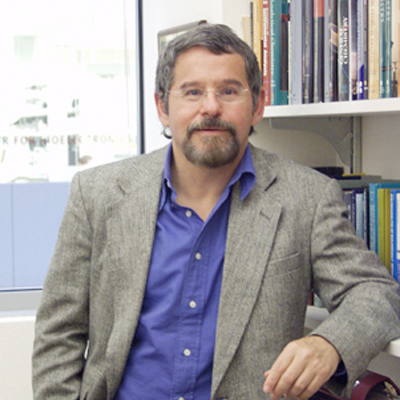Developing nanodevices for advanced biomedical and environmental applications
Imagine tiny robots or machines at the scale of a nanometer that can swim inside the body or in the ocean. In the body, these nanomachines can release drugs more effectively; in the ocean, they can measure contamination levels more accurately. Or, imagine wearable sensors that can safely and efficiently identify human biomarkers. Professor Joseph Wang, Chair of Nanoengineering at the University of California, San Diego, pioneers the developing fields of nanobioelectric, deploying the power of nanotechnology to facilitate practical biomedical and environmental applications. Advancing technology through nanomachines and nanobiosensors, Prof. Wang hopes to enable therapeutic, diagnostic, and environmental tools that have not been available before.
An international leader with over 940 research papers, 35 patents, 38 chapters and 12 books, Prof. Wang directs a nanobioelectronic team of almost 20 researchers working on nanomachines and 20 on nanobiosensors. The team’s highly multidisciplinary research combines fundamental studies from different disciplines with forward-looking engineering efforts, including nanomachines, nanosensors, electrochemistry and analytical chemistry. By developing new designs based on new shapes and materials, Prof. Wang and his team hope to accelerate advancements that will have direct applications to benefit society.
Current projects include:
- Advanced Nanomachines for Future Applications: From delivering medicine directly to a cancerous tumor or other diseased tissue to nanosubmarines for cleaning up oil spills and capturing and removing nerve-agent pesticides, the nanomachines carry new functionality and capability that operate on nanomotors generated by locally supplied fuels. Efficient energy conversion is therefore crucial for the successful use of nanomotors as power-generating engines for nanoscale devices. Professor Wang and his team at UCSD are thus designing versatile and powerful energy-efficient nanomachines and nanorobots, along with sophisticated schemes for their precise motion control for broad range of practical biomedical and environmental applications. Major areas of impact include:
- New and Powerful Nanomachines
- Biomedical Applications
- Environmental Applications
- Security Applications
- Glucose Monitoring
- Bionanosensors for Medical Support and Security: The nanobiosensors are small devices that provide real-time, on-site detection and analysis designed to eliminate the need for sample collection, preparation and laboratory analysis. Such devices rely on the judicious and intimate coupling of a chemical or biological recognition layer and a physical transducer (e.g. electrode, fiber optic), and the goal is to convert the selective chemical or biological recognition event into a useful electrical signal. The development of advanced chemical sensors and biosensors thus requires proper attention to both the recognition layer and the physical transducer, as well as to the coupling of these recognition and transduction events. The team is exploring the fundamental aspects of the recognition and transduction events, developing and characterizing new coating materials and electrode transducers and designing new microsensors for clinical diagnostics, environmental monitoring, security surveillance, or industrial process control. Major applications include:
- Wearable Sensors: The creation of epidermal sensing devices able to conform to the contours of the human anatomy is currently receiving considerable attention in Dr. Wang’s labs towards non-invasive chemical monitoring. Providing comprehensive information regarding the performance of an individual’s body, these sensors yield significant insight into the overall health status of the wearer in connection to diverse healthcare, fitness and military applications. Currently, wearable biofuel cells are being developed for powering these on-body sensors, and advanced sensors for 'on-the-spot' forensic applications are being developed towards field identification of explosives or gunshot residues.
- Glucose and Diabetic Management: Our advanced wearable sensor technology can measure the glucose level for patients with diabetes in a non-invasive and minimally invasive manner. Further advancement of this device technology will help treat diabetes and improve patients’ compliance.
- Security in Environmental Monitoring: wearable and remote sensors for monitoring explosives, contaminants and gunshot residues.
Bio
Professor Joseph Wang is currently a SAIC Endowed Chair and Distinguished Professor in the Department of Nanoengineering at University of California, San Diego. Previously, he was a Professor of the Department of Chemical Engineering at Arizona State University (ASU) and Director of Center for Bioelectronics and Biosensors at the Biodesign Institute. He obtained his higher education at the Technion and was awarded his D.Sc. in 1978. From 1978 to 1980 he served as a research associate at the University of Wisconsin (Madison) and joined New Mexico State University (NMSU) in 1980. From 2001-2004, he held a Regents Professorship and a Manasse Chair positions at NMSU. Since 1980, 20 Ph.D. candidates and 130 research associates and visiting scholars have studied with Professor Wang.
Professor Wang has authored over 940 research papers, 35 patents, 38 chapters and 12 books. His enthusiasm and willingness to collaborate with colleagues have made him a very popular member of the international electrochemical community. Professor Wang has presented more than 300 invited and plenary lectures in 60 countries. He is currently serving as the Chief Editor of the international journal Electroanalysis and has been a member of the Advisory Editor Board of several other international journals.
He has been in this field for over 40 years; he first moved to the United States in the late 1970s in search of a better outlet to help the society. He has since been very successful in solving practical problems and training a young generation of scientists, and is fortunate to have witnessed the continual growth in technology and in humanity. “We are always solving problems, and as a result, moving forward;” he recounts, “In the 1980s we saw the revolution of classic sensors, and in the 1990s we saw the rise of new materials and diagnostic tools, along with nanomachines.” He remarks that every 8~10 years, or every generation, we are not only advancing technology but also improving the quality of life, and he is happy to be able to contribute his knowledge and his expertise. He is an international leader in nanoengineering and electrochemistry, and educating young scientists to carry on the legacy is his major passion.
Outside of his lab, he thoroughly enjoys living in the beautiful city of San Diego, and likes to stroll through the beach at the La Jolla Shores or the Shelter Island for two or three hours on a Saturday morning.
For more information, visit http://joewang.ucsd.edu
In the News
Biology News Net
U-T San Diego
Publications
Awards
American Chemical Society Awards, 1999 and 2006
ISI 'Citation Laureate' Award, during 1991-2001
Heyrovsky Memorial Medal (of the Czech Republic), 1994
Special Creativity Award, 2008
Honorary Professor from National University, 2004
Patents
U.S. Patent No. 5,192,412: "Method and Apparatus for Batch Injection Analysis."
J. Wang and Z. Taha, 1993.
Int. Patent GO1N 33/48, 27/327: "Use of Benzene Derivatives as Charge Transfer Mediators."
T. Rassmussen, J. Kulys, J. Wang and M. Ozsoz.
U.S. Patent No. 5,292,423: "Methods and Apparatus for Trace Metal Testing."
J. Wang, 1994.
U.S. Patent No. 5,676,820: “Remote Electrochemical Sensor.”
J. Wang and K. Olsen, 1997.
U.S. Patent No. 5,942,103: “Renewable Electrochemical Sensors.”
J. Wang and K. Olsen, 1999.


